ASUS A88X-Pro Review: Kaveri, Kaveri, Quite Contrary
by Ian Cutress on April 22, 2014 11:59 AM EST- Posted in
- Motherboards
- AMD
- Asus
- Kaveri
Scientific and Synthetic Benchmarks
2D to 3D Rendering –Agisoft PhotoScan v1.0: link
Agisoft Photoscan creates 3D models from 2D images, a process which is very computationally expensive. The algorithm is split into four distinct phases, and different phases of the model reconstruction require either fast memory, fast IPC, more cores, or even OpenCL compute devices to hand. Agisoft supplied us with a special version of the software to script the process, where we take 50 images of a stately home and convert it into a medium quality model. This benchmark typically takes around 15-20 minutes on a high end PC on the CPU alone, with GPUs reducing the time.
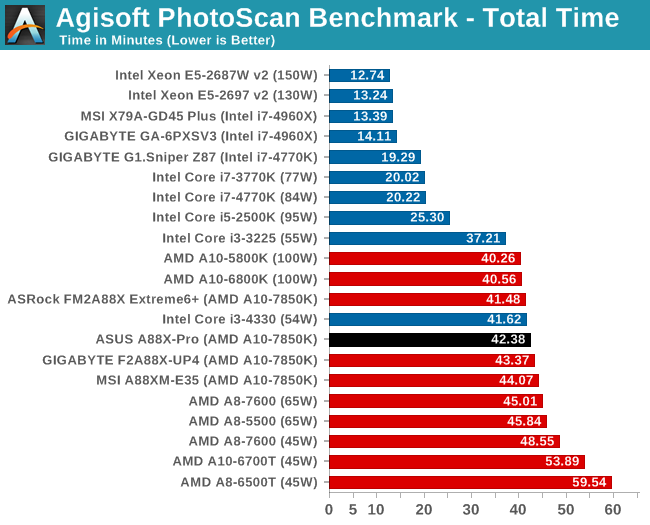
Console Emulation –Dolphin Benchmark: link
At the start of 2014 I was emailed with a link to a new emulation benchmark based on the Dolphin Emulator. The issue with emulators tends to be two-fold: game licensing and raw CPU power required for the emulation. As a result, many emulators are often bound by single thread CPU performance, and general reports tended to suggest that Haswell provided a significant post to emulator performance. This benchmark runs a Wii program that raytraces a complex 3D scene inside the Dolphin Wii emulator. Performance on this benchmark is a good proxy of the speed of Dolphin CPU emulation, which is an intensive single core task using most aspects of a CPU. Results are given in minutes, where the Wii itself scores 17.53; meaning that anything above this is faster than an actual Wii for processing Wii code, albeit emulated.
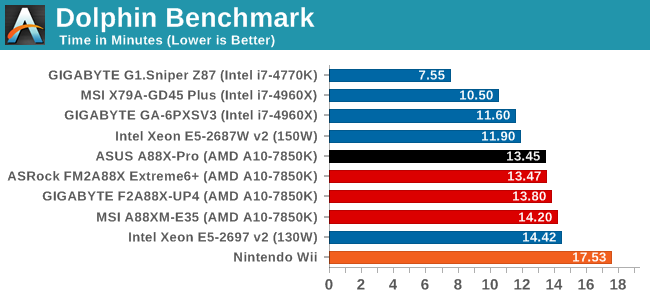
Point Calculations – 3D Movement Algorithm Test: link
3DPM is a self-penned benchmark, taking basic 3D movement algorithms used in Brownian Motion simulations and testing them for speed. High floating point performance, MHz and IPC wins in the single thread version, whereas the multithread version has to handle the threads and loves more cores.
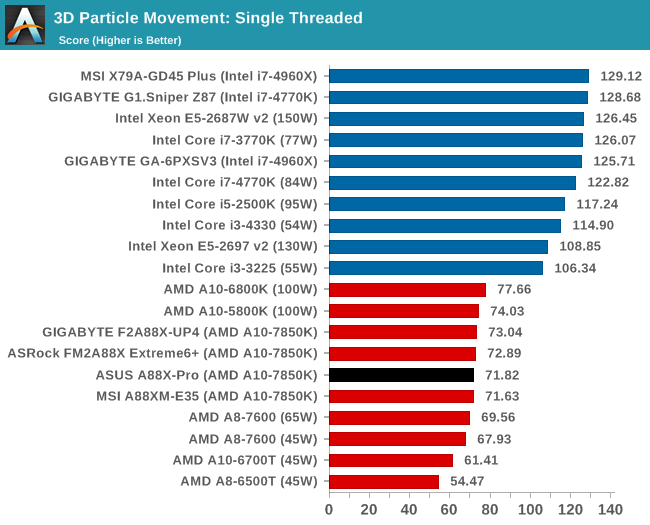
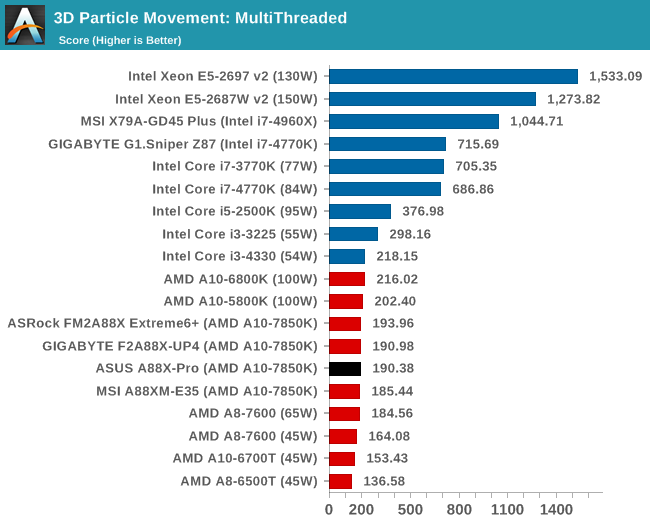
Encryption –TrueCrypt v0.7.1a: link
TrueCrypt is an off the shelf open source encryption tool for files and folders. For our test we run the benchmark mode using a 1GB buffer and take the mean result from AES encryption.

Synthetic – 7-Zip 9.2: link
As an open source compression tool, 7-Zip is a popular tool for making sets of files easier to handle and transfer. The software offers up its own benchmark, to which we report the result.
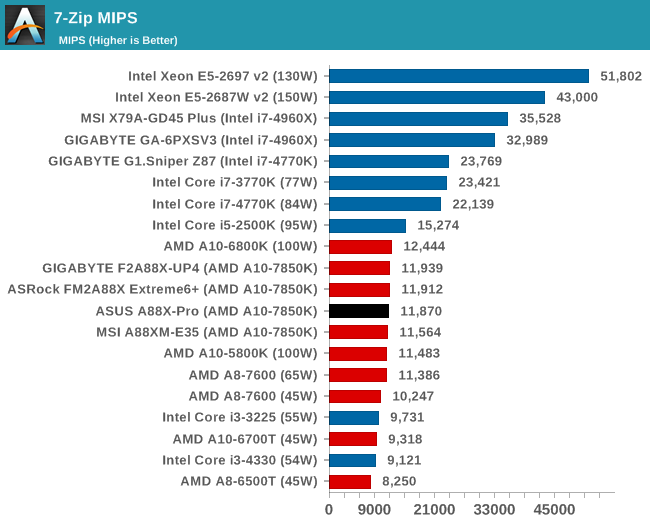










34 Comments
View All Comments
Ortanon - Tuesday, April 22, 2014 - link
EXACTLY. I've been scratching my head on this one. The only possible argument would be that you can cram more gaming into a smaller case, but that's an idiotic argument because 1) who the hell is so desperate to fit a system down to the millimeter and 2) the real-life difference between mini-ITX and micro-ATX cases is often one or two inches in any given dimension.So ultimately Kaveri is, unfortunately, a bust. A moot point. A waste of precious R&D resources. And it's such a shame.
On the bright side, all they'd have to do is adjust the price point. A lot.
Topweasel - Tuesday, April 22, 2014 - link
Obviously you haven't tried to build a computer in SG05 or Ncase M1. Not every ITX case is Prodigy or 250D. Most are much much much smaller in all dimensions than most mATX cases. I would say it's more of the ATX vs mATX that's always bothered me. More often than not an mATX case isn't much smaller than a well spaced full ATX mid tower.That said this motherboard is about as useless as one could be. I see why they are doing it. They want full sized full featured ATX boards for the AMD platform, but with AMD almost completely shutting down AM3+ developments, the future of AMD's platforms is in the FM2 and up. Spending 200$ on a full ATX system just to use integrated video doesn't make sense. I guess one could say there is more performance and power savings when tied to discrete AMD GPU. But APU's are at their best when they are the sole source of video. Certainly not worth spending i5 money otherwise. Which is why it would work best in an ITX setup where both space and cooling are enough of a issue that one would rather do without a discrete card if possible.
PEJUman - Tuesday, April 22, 2014 - link
^^ ThisI was able to purchase the 7850K for 120 at local microcenter and a Asrock A88X-ITX+ for 100 at newegg. At $220 combined price, Kaveri is very hard to pass up. yes, you can get cheaper systems, but it's price/performance/size/power ratio is unique. This is no longer the case if you approach $300. They really need to drop the price down to around 100 for the CPU.
just4U - Tuesday, April 22, 2014 - link
I'd have to agree with that.. Which is why I am waiting on the A8s Their supposed to be priced in and around 90-120 which is somewhat of a sweet spot. As we move up to the 150-180 dollar A10s that drops off a little as you could always pair a discrete card (say a GDR5 240 or something) and blow it all out of the water.BinaryTB - Tuesday, April 22, 2014 - link
HTPCs. Lower heat, lower noise, lower power consumption.CPU and graphics don't matter much if you can decode high bitrate video in hardware and put it all in a small package.
The same argument could be used for laptops as well.
But I do agree with you, if you have a desktop and want performance, separates is the way to go.
eanazag - Tuesday, April 22, 2014 - link
Power consumption and heat are the difference. I do agree with just4U that I really just wanted the A8-7600. With the price about a $100 it makes more sense to me. I think the OEMs cried for it so we got shafted in channel.abufrejoval - Tuesday, April 22, 2014 - link
I'm guessing as to what you'd want: A <95Watt TDP APU, which still has the biggest GPU AMD can make... I think you're willing to sacrifice CPU clock for low TDP, but not graphics performance and would like to hit the 65 or 45 Watt "sweet spots", right?Well you don't need to actually wait for anything: These APUs are all one single die anyway, including all the mobile variants (once they come).
And, at least on Asus, you have the ability to configure your desired TDP in the BIOS, at least between 40 (could be 45) and 65 Watts.
Here is what happens:
You leave that setting alone, you'll get a 95Watts part, which means 3.7 GHz base, while it will clock to 4.0GHz as long as the thermal budget lasts.
You set it to any number between 65 and 40/45 and you'll get exactly that: An APU which will fiddle with GPU and CPU budgets until they meet your TDP limit.
You use single threaded CPU load at 45Watts TDP, you may well get 4.0 GHz for quite a while.
You use tons of GPU, your CPU may well slow to the 1 GHz range (actually I believe it won't drop below 1.6GHz).
So with previous generation APUs like Trinity and Richmond the TDP settings were hard-wired into the die before packaging and sale. With Kaveri, from what I am seeing, there is really just two variants: One with 512 graphic cores enabled and one with 384 graphic cores enabled. Everything else is configuration done completely in software, which is just perfect from where I stand ;-)
I can buy a Kaveri today and push it to its absolute limits with heavy overclock on a "Pro" mainboard and I can transfer it into a mini-ITX board tomorrow and tell it to never use beyond 45Watts and it will just do as it was told!
Completely anti-market-segmentation and just the way I like it as a *consumer*.
pidgin - Tuesday, April 22, 2014 - link
I really regret going with ASRock FM2A88X Killer+, nothing but memory problems, basically no driver updates on driver page, ughhtuklap - Friday, April 25, 2014 - link
seems that you have to take it unto asrock.. I was targetting ASRock FM2A88X Killer+ too but when I read some problems and noticed that there are no driver updates i switched my eye to asrock fm2+ extreme6+ ^_^ never had problems.. although I wish they have esd protections and anti-surge ic's placed on the board. also they should have made it sturdier.all in all quite happy.
this board is solid. but the thing here is it lacks on board switches for power and reset
tech6 - Tuesday, April 22, 2014 - link
I'm sure this is a great boar but none of this matters until AMD release a CPU that is power consumption and performance competitive with what Intel is currently offering. The AMD on board graphics are great but the rest of the CPU and the power consumption are currently simply not competitive.